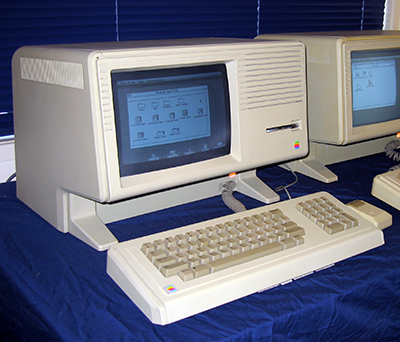| Tweet |
Apple Lisa 2
 (Note: Click on the image for a larger view. I also describe this machine in a YouTube video)
(Note: Click on the image for a larger view. I also describe this machine in a YouTube video)
During a 1978 visit to Xerox's Palo Alto research facility Steve Jobs saw the future. That future was the mouse-drive graphical user interface or GUI, something so ubiquitous now it's not even worth highlighting. Not so back then though when the usual computer<--> human interface was typed commands consisting of gobbledygook which only the initiated understood.
Inspired by the Xerox visit, Jobs started the Lisa project to bring this technology into the mainstream. The result was the 1983 Apple Lisa, a stylish "friendly looking" GUI-based machine for the office. The technology was revolutionary. Unfortunately so much so third-party developers had problems writing software for it. That is if they could afford a machine in the first place! Going on the market at a stratospheric $US10,000 a unit didn't make for many sales especially when good old reliable IBM PC/XTs could be dumped on workers' desks for half the price. There were other problems too. The original 5.25 inch "twiggy" drives were flakey and the 6800 processor struggled under the weight of all that GUI activity.
Jobs himself didn't help matters either. Having initiated the Lisa project, he fell out with a number of the key developers and was forced off the project. He then tended to regard it more as a "proof-of-concept" and focused his attention on developing and marketing a new younger sibling, the Macintosh. Support for the Lisa suffered as a result.
Given the problem with the twiggy drives, the Lisa was redesigned in 1984 to hold a (then innovative) Sony 400k 3.5 inch drive and an optional external hard disk (the Lisa 2/5). Soon this was joined by a similar model with an internal hard disk (Lisa 2/10). The price was also halved. While a hard-drive enabled Lisa 2 was quite usable, it was still an expensive machine which was now losing ground not only to the corporate-loved IBM PC/XT but also the Macintosh itself. In total, not a lot were sold by the end of its run, which have lead to some computer historians to refer to it as "the Edsel" of microcomputers. However, despite its short life (1983-1985) and poor showing in the market there is no doubting its influence on computer development. It's a classic, historical computer which every serious collector should have.
Although I only wanted one Lisa, I ended up with three! Two Lisa 2/5s and a Lisa 2/10. I've fixed one Lisa 2/5 (the one in the background) and also repaired the Lisa 2/10 (aka Macintosh XL) (the one on the foreground). The repaired Lisa 2/5 has been sold to a New Zealand collector. I'll keep the third one for spares.
Update: My Lisa 2's have now been passed on to new owners. I'm confident they will appreciate them as much as I did.
Want to know more about this micro? Google is your friend.
This page last edited 27th August, 2022
| Tweet |